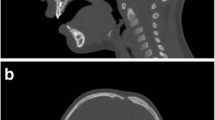Abstract
Purpose
Craniosynostosis may lead to reduced intracranial volume (ICV) and disturb normal brain growth and development. Thus, ICV is an important parameter with respect to the surgical outcome. Current methods for ICV determination from computed tomography (CT) images have drawbacks. The aim of this study was to investigate the performance of the novel mesh-based method (MBM) for ICV determination with craniosynostosis patients.
Methods
Twenty-two patients operated on for scaphocephaly were included in this study. ICVs from preoperative, one-week postoperative, and one-year postoperative CT images were measured with MBM. The level of agreement with the manual segmentation method (MSM) was determined for the measurements of preoperative and one-year postoperative datasets. Repeatability was determined with re-measurements of six datasets. Measurement time was recorded for MBM.
Results
Mean \((\pm \text{ SD})\) preoperative ICV values were 895.0 \(\pm \) 153.1 \(\text{ cm}^{3}\) and 896.4 \(\pm \) 147.2 \(\text{ cm}^{3}\) as measured with MBM and MSM, respectively. Corresponding one-year postoperative values were 1,238.3 \(\pm \) 118.7 \(\text{ cm}^{3}\) and 1,250.1 \(\pm \) 117.5 \(\text{ cm}^{3}\). The MBM allowed ICV determination from one-week postoperative datasets. Measurement time with MBM was 4
Conclusions
MBM is an efficient method for determining the ICV of craniosynostosis patients, allowing the measurement of skulls with bony defects. The repeatability and short measurement time of MBM are attributable to the user interference and assessment of the measurement process.





Similar content being viewed by others
References
Terner JS, Travieso R, Lee S-S, Forte AJ, Patel A, Persing JA (2011) Combined metopic and sagittal craniosynostosis: is it worse than sagittal synostosis alone? Neurosurg Focus 31(2):E2
Hill CA, Vaddi S, Moffitt A, Kane AA, Marsh JL, Panchal J, Richtsmeier JT et al (2011) Intracranial volume and whole brain volume in infants with unicoronal craniosynostosis. Cleft Palate Craniofac J 48(4):394–398
Lee S-S, Duncan CC, Knoll BI, Persing JA (2010) Intracranial compartment volume changes in sagittal craniosynostosis patients: influence of comprehensive cranioplasty. Plastic Reconstr Surg 126(1):187–196
Nowinski D, Saiepour D, Leikola J, Messo E, Nilsson P, Enblad P (2011) Posterior cranial vault expansion performed with rapid distraction and time-reduced consolidation in infants with syndromic craniosynostosis. Child’s Nerv Syst 27(11):1999–2003
Schaller BJ, Filis A, Merten HA, Buchfelder M (2012) Premature craniosynostosis-the role of skull base surgery in its correction. A surgical and radiological experience of 172 operated infants/children. J Cranio Maxillofac Surg 40(3):195–200
Steinbacher DM, Skirpan J, Puchała J, Bartlett SP (2011) Expansion of the posterior cranial vault using distraction osteogenesis. Plastic Reconstr Surg 127(2):792–801
Taylor JA, Maugans TA (2011) Comparison of spring-mediated cranioplasty to minimally invasive strip craniectomy and barrel staving for early treatment of sagittal craniosynostosis. J Craniofac Surg 22(4):1225–1229
Sahin B, Acer N, Sonmez OF, Emirzeoglu M, Basaloglu H, Uzun A, Bilgic S (2007) Comparison of four methods for the estimation of intracranial volume: a gold standard study. Clin Anat 20(7): 766–773
Pengas G, Pereira JMS, Williams GB, Nestor PJ (2009) Comparative reliability of total intracranial volume estimation methods and the influence of atrophy in a longitudinal semantic dementia cohort. J Neuroimaging 19(1):37–46
Sgouros S, Hockley AD, Goldin JH, Wake MJ, Natarajan K (1999) Intracranial volume change in craniosynostosis. J Neurosurg 91(4):617–625
Mazonakis M, Karampekios S, Damilakis J, Voloudaki A, Gourtsoyiannis N (2004) Stereological estimation of total intracranial volume on CT images. Eur Radiol 14(7):1285–1290
Acer N, Sahin B, Baş O, Ertekin T, Usanmaz M (2007) Comparison of three methods for the estimation of total intracranial volume: stereologic, planimetric, and anthropometric approaches. Ann Plast Surg 58(1):48–53
Mazonakis M, Damilakis J, Maris T, Prassopoulos P, Gourtsoyiannis N (2002) Comparison of two volumetric techniques for estimating volume of intracerebral ventricles using magnetic resonance imaging: a stereological study. J Magn Reson Imaging 15(5): 131–139
de Oliveira ME, Ritvanen A, Hallila H et al A mesh-based method for assessing intracranial volume. Comput Methods Prog Biol (submitted)
Salyer K, Marchac D (1999) Chapter 2: Surgery of craniosynostosis in infants. In: Salyer KE, Bardach J (eds) Atlas of craniofacial and cleft surgery, vol 1. Lippincott-Raven, Philadelphia, pp 86–88
Arnaud E, Marchac D, Renier D (2006) The treatment of craniosynostosis: indications and techniques. Neurochirurgie 52:264–291 (in French)
Arnaud E, Capon-Degardin N, Michienzi J, Di Rocco F, Renier D (2009) Scaphocephaly part II: secondary coronal synostosis after scaphocephalic surgical correction. J Craniofac Surg 20(Suppl 2):1843–1850
Bland JM, Altman DG (1986) Statistical methods for assessing agreement between two methods of clinical measurement. Lancet 1(8476):307–310
Altman DG, Bland JM (1983) Measurement in medicine. Anal Method Comp Stud 32:307–317
de Oliveira ME, Hallila H, Ritvanen A, Büchler P, Paulasto M, Hukki J (2011) Feature-invariant image registration method for quantification of surgical outcomes in patients with craniosynostosis: a preliminary study. J Pediatr Surg 46(10):E1–E8
Ambarki K, Lindqvist T, Wåhlin A, Petterson E, Warntjes JBM, Birgander R, Malm J et al (2012) Evaluation of automatic measurement of the intracranial volume based on quantitative MR imaging. Am J Neuroradiol 33(10):1951–1956
Heller JB, Heller MM, Knoll B, Gabbay JS, Duncan C, Persing JA (2008) Intracranial volume and cephalic index outcomes for total calvarial reconstruction among nonsyndromic sagittal synostosis patients. Plast Reconstr Surg 121(1):187–195
Acknowledgments
This research was funded by Tekes—The Finnish Funding Agency for Technology and Innovations, Aalto University and the Orton Foundation.
Conflict of interest
The authors declare that they have no conflict of interest.
Author information
Authors and Affiliations
Corresponding author
Electronic supplementary material
Below is the link to the electronic supplementary material.
11548_2013_822_MOESM1_ESM.wmv
Video, Supplemental digital content 1 The video presents a screen view of the measuring process of two patients with the MBM software. The value of ICV is shown in green figures in the bottom left of the screen.
Rights and permissions
About this article
Cite this article
Ritvanen, A.G., de Oliveira, M.E., Koivikko, M.P. et al. Mesh-based method for measuring intracranial volume in patients with craniosynostosis. Int J CARS 8, 703–709 (2013). https://doi.org/10.1007/s11548-013-0822-x
Received:
Accepted:
Published:
Issue Date:
DOI: https://doi.org/10.1007/s11548-013-0822-x




